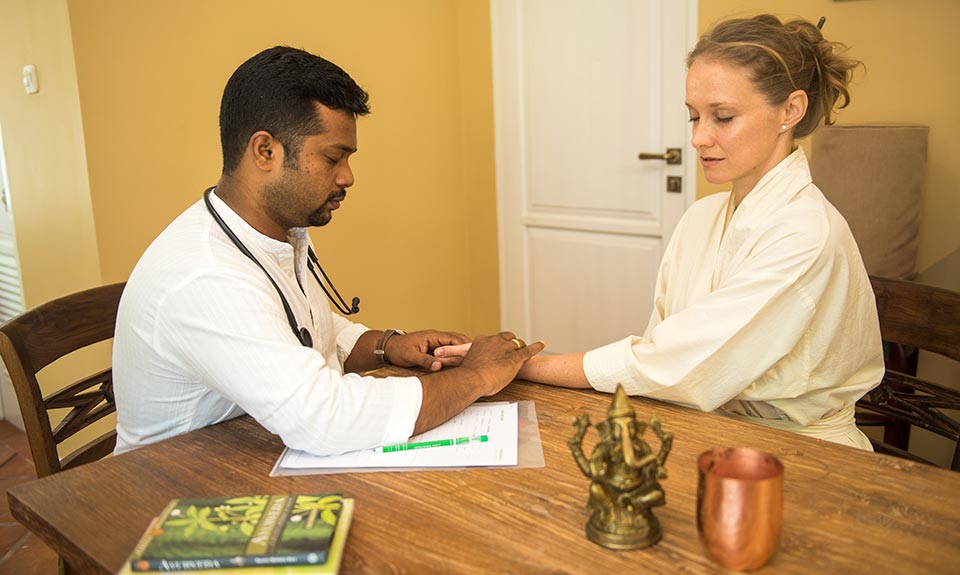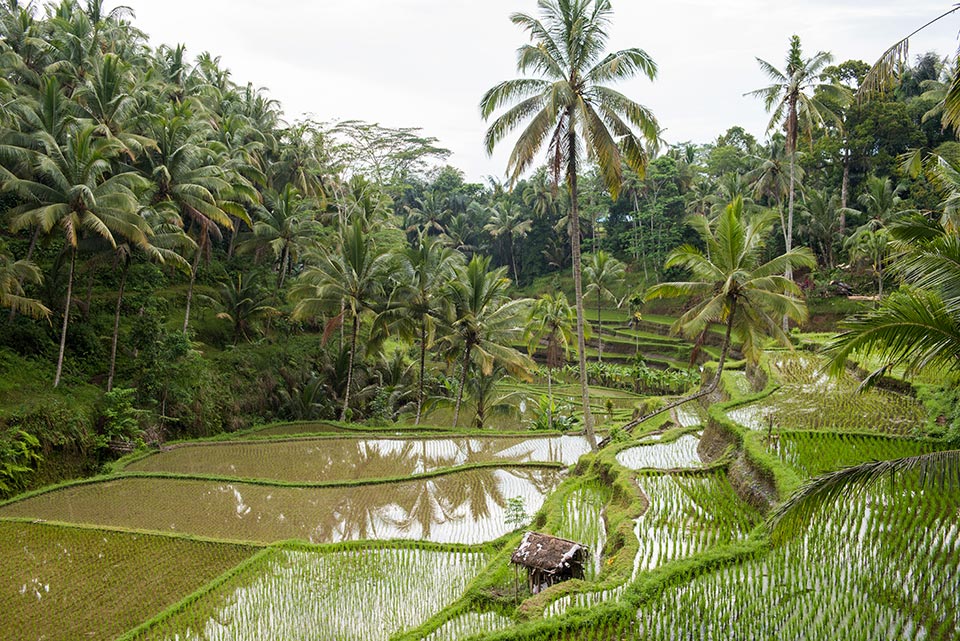
Ayurveda the Science of Life – The Maha Gunas, the Five Elements, and the Doshas
 Ayurveda is the time-tested, natural, prevention-oriented, and holistic health care system of ancient India. This over 5000-year-old science considered the mother of healing, defines health as the balance of the Body, the happiness of Mind, clarity of Intellect, feverishness-free Senses, and a pleasant Soul. Ayurveda advocates that living in harmony with nature and maintaining harmony between body, mind and spirit contribute to a long and healthy life. Any imbalance in this harmony results in disease. The focus of Ayurveda is on preventive and curative aspects as well as a holistic approach to treatment. In the past 20 years, Ayurveda has undergone a resurgence. It is now practiced all over the world and often works in harmony with a more modern approach, having been recognized by the WHO.
Ayurveda is the time-tested, natural, prevention-oriented, and holistic health care system of ancient India. This over 5000-year-old science considered the mother of healing, defines health as the balance of the Body, the happiness of Mind, clarity of Intellect, feverishness-free Senses, and a pleasant Soul. Ayurveda advocates that living in harmony with nature and maintaining harmony between body, mind and spirit contribute to a long and healthy life. Any imbalance in this harmony results in disease. The focus of Ayurveda is on preventive and curative aspects as well as a holistic approach to treatment. In the past 20 years, Ayurveda has undergone a resurgence. It is now practiced all over the world and often works in harmony with a more modern approach, having been recognized by the WHO.
THE MAHA GUNAS, THE FIVE ELEMENTS, AND THE DOSHAS
Maha Gunas are mental/spiritual energies, the primary qualities or attributes of nature, or that which the manifest universe is composed of – intrinsic qualities which are inherent in everything. These energies are called Sattva, Rajas, and Tamas.
Sattva is a state of equilibrium and balance. It imparts love, compassion, peace and positivity, freshness, alertness, awareness, luster, wisdom, happiness and joy. Predominantly sattvic people are calm, spiritually-minded, quiet, intelligent and health-conscious.
Rajas is best described as kinetic energy that results in activity. It imparts ego, aggression, over-ambitiousness, pride, competitiveness, a tendency to control others, over-attachment to power, prestige, awareness of position, fear of failure, a tendency to be angry and jealous. A predominantly rajasic person is ambitious, driven, egotistical and a perfectionist.
Tamas is darkness, inertia, heaviness, and the tendency towards materialism. Excess tamas result in depression, laziness, over-indulgence in sleep, addictions and sex as well as in greed, attachment and lack of care towards others. When all three psychic energies are in balance, the Sattvic mind lends itself toward calm, clear, creative thinking that allows one to easily find effective solutions to life’s problems. Then, we need the lesser qualities of Rajas to implement these solutions and Tamas to help bring these activities to completion.
Together, the maha gunas form the five elements.
Everything in the universe is created from a certain ratio of these elements – Ether, Air, Fire, Water, and Earth – and they condense to form three bio-energies (doshas) in the body. Tridosha defines the three fundamental energies or principles which govern the function of our bodies on the physical and emotional levels. These three energies are known as Vata, Pitta and Kapha. Each individual has a unique balance of all these energies. Some people are predominantly one, while others are a mixture of two or more.
THE THREE DOSHAS
Your constitution (dosha) is evaluated from three different aspects; physical type, physiological traits and psychological characteristics. Ayurvedic therapy is based on knowledge of your constitution – of your unique body-mind condition (prakriti) with which you are born. Ayurveda sees illness as a product of your lifestyle along with invasion by an outside force, and different constitutions depend on different approaches to maintain a healthy balance. The doshic types are:
VATA – kinetic energy or movement
PITTA – thermal energy/bio-chemical energy or heat
KAPHA – potential energy/bio-cohesive force or structure

VATA
 Vata is composed of the elements Air and Space and governs breathing, blinking of the eyelids, movements in the muscles and tissues, pulsations in the heart, all expansion and contraction, the movements of cytoplasm and the cell membranes, and the movement of the single impulses in nerve cells. It also governs feelings and sensations like freshness, nervousness, fear, anxiety, pain, tremors, spasms and touch. The primary seat or location of Vata in the body is the colon but it also resides in the hips, thighs, ears, bones, large intestine, pelvic cavity and skin.
Vata is composed of the elements Air and Space and governs breathing, blinking of the eyelids, movements in the muscles and tissues, pulsations in the heart, all expansion and contraction, the movements of cytoplasm and the cell membranes, and the movement of the single impulses in nerve cells. It also governs feelings and sensations like freshness, nervousness, fear, anxiety, pain, tremors, spasms and touch. The primary seat or location of Vata in the body is the colon but it also resides in the hips, thighs, ears, bones, large intestine, pelvic cavity and skin.
Here are some common characteristics of people who have a predominantly Vata constitution
- Creative, mentally alert
- Highly imaginative
- Quick to learn and grasp new knowledge, but also quick to forget
- Sexually easily excitable, but also quickly satiated
- Slender, the lightest of the three body types
- Talk and walk quickly
- A tendency toward cold hands and feet, discomfort in cold climates
- Excitable, lively, fun
- Changing moods
- Irregular daily routine
- Variable appetite and digestion
- High energy in short bursts; tendency to tire easily and to overexertion
- Full of joy and enthusiasm when in balance
- Respond to stress with fear, worry, and anxiety, especially when out of balance
- Tendency to act on impulse
- Racing, disconnected thoughts
- Dry skin and hair, not much perspiration
PITTA
P itta is composed of the elements Fire and Water. It governs digestion, absorption, assimilation, nutrition, metabolism, body temperature, skin coloration, the luster of the eyes, intelligence, and understanding. Psychologically, Pitta arouses anger, hatred and jealousy. The small intestine, stomach, sweat glands, blood, fat, eyes, and skin are the seats of Pitta.
itta is composed of the elements Fire and Water. It governs digestion, absorption, assimilation, nutrition, metabolism, body temperature, skin coloration, the luster of the eyes, intelligence, and understanding. Psychologically, Pitta arouses anger, hatred and jealousy. The small intestine, stomach, sweat glands, blood, fat, eyes, and skin are the seats of Pitta.
Here are some common characteristics of people who have a predominantly Pitta constitution
- Medium physique, strong, well-built
- Sharp mind, good concentration power
- Orderly, focused
- Assertive, self-confident and entrepreneurial at their best; aggressive, demanding, and pushy when out of balance
- Competitive, enjoy challenges
- Passionate and romantic; sexually have more vigor and endurance than Vatas, but less than Kaphas
- Strong digestion, strong appetite, get irritated if they have to miss or wait for a meal
- Like to be in command
- When under stress, become irritated and angry
- Skin fair or reddish, often with freckles; sunburn easily
- Hair usually fine and straight, tending towards blond or red, typically turns gray early and has a tendency toward baldness or thinning hair
- Uncomfortable in the sun or hot weather; heat makes them very tired
- Perspire a lot
- Others may find them stubborn, pushy, opinionated
- Good public speakers; also capable of sharp, sarcastic, cutting speech
- Generally good management and leadership ability, but can become bossy
- Like to spend money, surround themselves with beautiful objects
- Subject to temper tantrums, impatience and anger
- Typical physical problems include rashes or inflammations of the skin, acne, boils, skin cancer, ulcers, heartburn, acidic stomach, hot sensations in the stomach or intestines, insomnia, bloodshot or burning eyes and other problems with vision, anemia, jaundice
KAPHA
 Kapha is composed of the elements of Water and Earth. It cements the elements in the body, providing the material for physical structure and maintaining body resistance. Water is the main constituent of Kapha, and this bodily water is responsible physiologically for biological strength and natural tissue resistance. Kapha lubricates the joints and provides moisture to the skin, helps to heal wounds, fills the spaces in the body, gives biological strength, vigor and stability, supports memory retention, gives energy to the heart and lungs, and maintains immunity. Kapha is present in the chest, throat, head, sinuses, nose, mouth, stomach, joints, cytoplasm, plasma, and in the liquid secretions of the body such as mucus. Psychologically, Kapha is responsible for the emotions of attachment, greed, and long-standing envy. It is also expressed in tendencies toward calmness, forgiveness and love. The chest is the seat of Kapha.
Kapha is composed of the elements of Water and Earth. It cements the elements in the body, providing the material for physical structure and maintaining body resistance. Water is the main constituent of Kapha, and this bodily water is responsible physiologically for biological strength and natural tissue resistance. Kapha lubricates the joints and provides moisture to the skin, helps to heal wounds, fills the spaces in the body, gives biological strength, vigor and stability, supports memory retention, gives energy to the heart and lungs, and maintains immunity. Kapha is present in the chest, throat, head, sinuses, nose, mouth, stomach, joints, cytoplasm, plasma, and in the liquid secretions of the body such as mucus. Psychologically, Kapha is responsible for the emotions of attachment, greed, and long-standing envy. It is also expressed in tendencies toward calmness, forgiveness and love. The chest is the seat of Kapha.
Here are some common characteristics of people who have a predominantly Kapha constitution
- Easygoing, relaxed, slow-paced
- Affectionate and loving
- Forgiving, compassionate, nonjudgmental, stable, reliable, faithful
- Physically strong, with a sturdy, heavier build
- Have the most energy of all constitutions, but are steady and enduring, not explosive
- Slow-moving and graceful
- Slow speech, reflecting a deliberate thought process
- Slower to learn, but never forget, outstanding long-term memory
- Soft hair and skin, a tendency to have large “soft” eyes and low, soft voice
- A tendency towards being overweight may also suffer from sluggish digestion
- Prone to heavy, oppressive depressions
- More self-sufficient, need less outward stimulation than other types
- A mild, gentle, and essentially undemanding approach to life
- Sexually Kaphas are the slowest to be aroused, but also have the most endurance
- Excellent health, strong resistance to disease
- Not easily angered, strive to maintain harmony and peace in their surroundings
- Not easily upset and can be a point of stability for others
- Tend to be possessive and hold on to things, people, and money. Good savers.
- Do not like cold, damp weather

Aparna K. BAMS, MD, PhD
Aparna is one of the few specialists worldwide with a PhD in Ayurveda. Born into an Ayurvedic family which operates a traditional Ayurvedic Panchakarma hospital in Kerala, India, she grew up observing her father, the renowned Dr Padmanabhan.


Leave a Reply